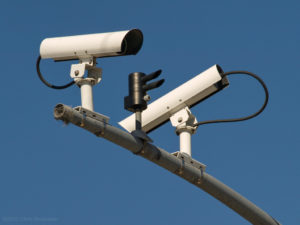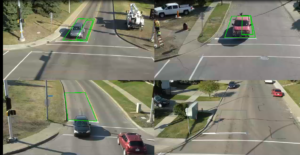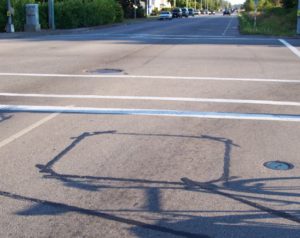History has seen all kinds of myths associated with this topic. Some would say you just flash your lights, or honk your horn and the lights will change. This article will set out to debunk some of these myths and reveal the truth about how much you can actually impact the dreaded red signal phase.
Will Honking My Horn Change the Light to Green?
In the past, acoustic sensors, which could detect the sound of oncoming emergency vehicles were in fact used. They were activated by detecting specific patterns or frequencies. There are still some of these sensors around, but with the advent of GPS devices, acoustic sensors have seen a rapid decline and are all but obsolete. This technology did however allow some to honk their horn to change the signal phase to green assuming the horn was in excess of 120 dB (primarily large trucks and buses) and the vehicle was close enough to the sensor to activate it. As of today, honking your horn at a traffic signal is virtually useless, unless of course you wish to draw some unwanted attention to yourself.
What About Flashing My Lights?
Line-of sight detection, as these type of sensors are known, have also become less popular with the availability of the more accurate, functional, and versatile GPS systems. That said, lets assume you did happen to know where one of these sensors was still in use. Could you then change the light from red to green simply by flashing your lights? Well, unless you have a rapid flash super power the short answer is no. The sensors operate between a detection range of 10-14Hz (This is the frequency of beacons on emergency vehicles). This essentially means you would have to flash your high beams at a rate of up to 14 times per second, which in essence, effectively renders you powerless. Despite neither of the aforementioned granting you, the motorist, any sort of power over that sought after free flowing traffic lane, do not give up hope yet. You still have options.
So How Can I Affect The Change From Red To Green?
 Vehicle detection devices in use today are classified into two main categories. These are “In Roadway” and “Over Roadway”. In roadway devices are comprised of inductive loop detectors, magnetic sensors, pneumatic road tubes, piezoelectric sensors and weigh-in-motion devices. Over roadway devices include video image processors, infrared, ultrasonic, microwave and passive acoustic array sensors. Some of these sensors have very specific purposes and uses that do not, in general, affect your ability to impose dominance over the red signal phase. So for the purpose of this discussion, lets focus on the ones most common in our day to day excursions, the ones we can affect. The first is Video Image Processors or VIP’s.
Vehicle detection devices in use today are classified into two main categories. These are “In Roadway” and “Over Roadway”. In roadway devices are comprised of inductive loop detectors, magnetic sensors, pneumatic road tubes, piezoelectric sensors and weigh-in-motion devices. Over roadway devices include video image processors, infrared, ultrasonic, microwave and passive acoustic array sensors. Some of these sensors have very specific purposes and uses that do not, in general, affect your ability to impose dominance over the red signal phase. So for the purpose of this discussion, lets focus on the ones most common in our day to day excursions, the ones we can affect. The first is Video Image Processors or VIP’s.
Video Image Processors
You will have by now seen these cameras perched atop various traffic or street lights. No, they are not speed or red light cameras. More about that here. VIP’s use one or more cameras at a particular location to collect and assess traffic data. This data is run through a microprocessor to create a digital image within a specified frame. This data then enables the software to interpret and respond accordingly. Essentially, the camera is focused on a specific point or “frame” (see picture on the right) and makes notice of changes within that frame. Simply put, if the frame remains empty (no vehicles enter the cameras view) the signal will then run it’s normal course and change when the default time limit is met. On the other hand, if a vehicle is detected within the frame, the software, through use of various algorithms and pre-determined parameters, will then decide how to give priority to maintain optimal flow. It is by this method you will be detected and the ever elusive green light will be yours! You might be asking yourself, well that’s fine, but how will I know I’m within the frame and thus detected? Well rest assured you are! The detection zones are large, so unless you are in the ditch or parked a seriously far distance back from the signal you will be detected and placed accordingly within the queue. If simply being detected is not enough to satisfy your desire to change signal phases, fear not, there is one more fairly common option.
This data then enables the software to interpret and respond accordingly. Essentially, the camera is focused on a specific point or “frame” (see picture on the right) and makes notice of changes within that frame. Simply put, if the frame remains empty (no vehicles enter the cameras view) the signal will then run it’s normal course and change when the default time limit is met. On the other hand, if a vehicle is detected within the frame, the software, through use of various algorithms and pre-determined parameters, will then decide how to give priority to maintain optimal flow. It is by this method you will be detected and the ever elusive green light will be yours! You might be asking yourself, well that’s fine, but how will I know I’m within the frame and thus detected? Well rest assured you are! The detection zones are large, so unless you are in the ditch or parked a seriously far distance back from the signal you will be detected and placed accordingly within the queue. If simply being detected is not enough to satisfy your desire to change signal phases, fear not, there is one more fairly common option.
Inductive Loop Detectors
 Throughout your travels you may have noticed a portion of the roadway, near stoplights, that looks as if it has been cut and filled with a substance that resembles tar. Well that’s because it has. These rectangles affront the stop line are known as Inductive Loop Detectors. An industrial saw is used to insert a small cut into the asphalt where loop wire is then placed. Once properly seated and routed to the controller, the cut is then filled with a special sealant commonly referred to as “loop goop”. The system works by detecting a decrease in the inductance of the loop when compressed by motorists. The decreased inductance increases the oscillation frequency and is detected by the controller thus alerting the presence of a vehicle. So, in order to exercise your influence on these guys, be sure you have crossed over the sensor. If there is someone who is stationary behind the sensor and has not activated it, try moving into the next lane where you are sure to find another one. You might be asking yourself, what about motorcycles? Can loops detect smaller vehicles? In short, yes. Loop technology has come a long way, and assuming all the parameters are set up correctly, Inductive Loop Detectors can detect even the smallest changes in oscillation, even cyclists!
Throughout your travels you may have noticed a portion of the roadway, near stoplights, that looks as if it has been cut and filled with a substance that resembles tar. Well that’s because it has. These rectangles affront the stop line are known as Inductive Loop Detectors. An industrial saw is used to insert a small cut into the asphalt where loop wire is then placed. Once properly seated and routed to the controller, the cut is then filled with a special sealant commonly referred to as “loop goop”. The system works by detecting a decrease in the inductance of the loop when compressed by motorists. The decreased inductance increases the oscillation frequency and is detected by the controller thus alerting the presence of a vehicle. So, in order to exercise your influence on these guys, be sure you have crossed over the sensor. If there is someone who is stationary behind the sensor and has not activated it, try moving into the next lane where you are sure to find another one. You might be asking yourself, what about motorcycles? Can loops detect smaller vehicles? In short, yes. Loop technology has come a long way, and assuming all the parameters are set up correctly, Inductive Loop Detectors can detect even the smallest changes in oscillation, even cyclists!
So there you have it. Those were two of the most popular methods of vehicle detection. By adhering to above mentioned guidelines, you now know how, in all truth, you are able affect the change from red to green. I realize it may not be the unrestricted authority you were hoping to wield, but it is what’s out there. Please, if you enjoyed reading this article don’t forget to like and share! To read more articles like this click here.
